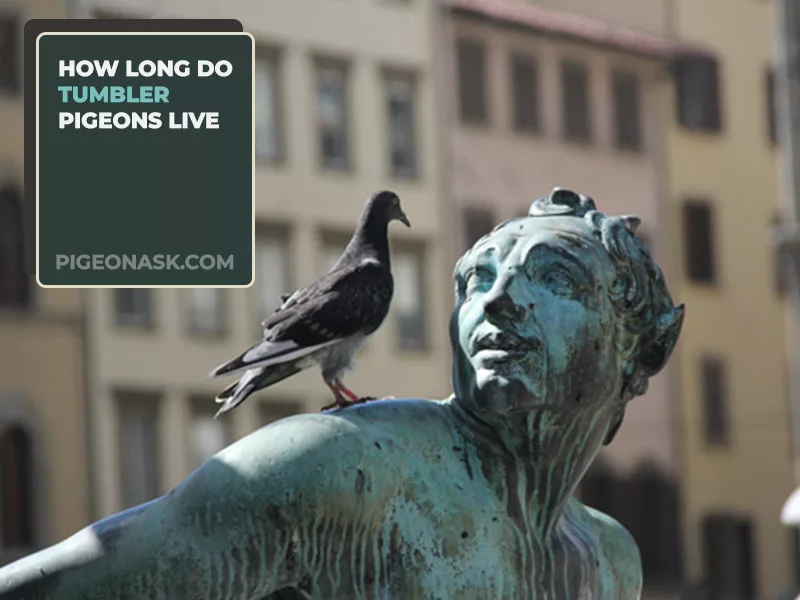Why Do Pigeons Tumble?
Pigeons have been domesticated for over ten thousand years, as far back as the Neolithic age. In these years, they have had a lot of uses for humans, from delivering messages to saving lives lost at sea.
However, they made a significant impact when people discovered some species of pigeons tumbling mid-flight. While most people raced to find and interbreed pigeons in order to hone this skill, others wondered, why do pigeons tumble? The answer is quite simple − it is in their genes.
Scientists believe that tumbling and rolling pigeons have a “RO” gene in their DNA that makes them more inclined to tumbling in the air during flight or even on the ground.
Let us get a closer look at how mankind trained these pigeons to enhance this symptom, and have had them performing in competitions and shows for decades.
Read more about pigeon habits:
What Causes Pigeons to Tumble?
As we mentioned above, pigeons require the “RO” gene in their DNA in order to be even trained to tumble and roll in the air.
To be honest, the “RO” gene is actually an anomaly that causes seizure-like symptoms. This can occur while the pigeons are in mid-air, causing them to momentarily lose control of their body and pirouette backwards, causing them to tumble.

It is impossible for the birds to learn how to tumble without this gene, as it is not a natural part of their evolution.
While many believe that it developed first as a survival tactic of dodging birds of prey, others believe that it has become out of control and may put the birds in mortal danger.
It is quite a dangerous trait for pigeons that are not trained, as it can cause them to crash into buildings and trees because they lose control of their bodies.
Oftentimes, when a pigeon tumbles mid-flight, it will not continue to fly and instead fall to the ground.
We have covered an in-depth article on “Pigeon Habits“; if interested, you can check this article here.
What is a Tumbler Pigeon Used For?
Tumbler pigeons are mostly used for exhibits by long term pigeon trainers and breeders. They perform at events, tumbling and rolling in the sky on cue, and enthusiasts love it.
They have been around since the 1500s and have been domesticated for most of these years, for this exact reason. When people discovered this trait, they began to cross-breed the best of the bests, enhancing that ability and keeping the gene alive.

These pigeons were trained long and hard from a very young age, and many do not survive the ordeal. Pigeon tumbling and rolling is just as popular a sport as pigeon racing even today.
With hundreds of shows taking place all over the world and clubs being formed by pigeon enthusiasts, it is unlikely that their popularity will fall any time soon.
Is a Tumbler a Breed of Pigeons?
A tumbler can be considered a breed of pigeons, but there are a variety of them. They can differ according to their colours, feather configurations, and body features.

It might be difficult to discern them from other pigeons who do not have the tumbler gene, but a lot of features are distinguishable enough to be used to detect them.
Let’s find out what they are!
How Do You Identify a Tumbler Pigeon?
Usually, tumblers have round heads that protrude from their faces more than other varieties of pigeons.
They have thick necks most of the time, and medium to short beaks. The colour of their eyes, beaks, and plumage varies from breed to breed.
There are a lot of tumbler pigeon breeds in this world, some of the well-known ones are –
- Berlin Long-Faced Tumbler
- Australian Performing Tumbler
- The Komorn Tumbler
How Long Do Tumbler Pigeons Live?
It might surprise you to know that the lifespan of tumbler pigeons can be as short as 3-5 years or up to 15-20 years, which is longer than most wild pigeons live.

As we mentioned, the life of a tumbler pigeon is challenging and requires a lot of endurance, both mentally and physically.
Training to Tumble
The training period, in particular, is difficult, as that is when most of the fatal accidents occur.
It is not uncommon for the pigeons to drop from the air when they are learning to tumble, crashing down to the ground head first.
They can also crash into other tall structures such as buildings or trees as tumbling can make them dizzy and lose their sense of direction.
Overall, it is not a great life when they are in their training phase.
Lifestyle With Pigeon Fanciers
The fact that pigeons are bred and raised by pigeon fanciers most often means that they have a more comfortable lifestyle than feral pigeons.
They are given a better, more nutritious diet, and protected from their natural predators under the shelter of humans.
They are taken care of all their lives, which leads to much longer lifespans than regular, wild pigeons.
Conclusion
With that, we bring our article on why do pigeons tumble to a close. With the “ro” gene in their DNA, we know that it is difficult for them to ignore the urge. Training them to tumble is just one of the ways to keep them safe!
We hope that you enjoyed reading this article and would appreciate your sharing with fellow pigeon enthusiasts who can benefit from our articles.
Do not forget to connect with us on Facebook, Twitter, and Pinterest to know more about pigeon care, history, and tips!
Article References:
- pigeoncontrolresourcecentre.org/html/about-pigeons.html
- nbrc.us/home-page/birmingham-roller-origins/
Image Credit:
- Photo by e-zara on Canva.com/photos
- Photo by jim gifford from Flickr.com
- Photo by resul on Adobe Stock
- Photo by gokcen on Adobe Stock
